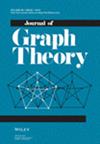Ramsey numbers upon vertex deletion
IF 0.9
3区 数学
Q2 MATHEMATICS
引用次数: 0
Abstract
Given a graph , its Ramsey number is the minimum so that every two-coloring of contains a monochromatic copy of . It was conjectured by Conlon, Fox, and Sudakov that if one deletes a single vertex from , the Ramsey number can change by at most a constant factor. We disprove this conjecture, exhibiting an infinite family of graphs such that deleting a single vertex from each decreases the Ramsey number by a super-constant factor. One consequence of this result is the following. There exists a family of graphs so that in any Ramsey coloring for (i.e., a coloring of a clique on vertices with no monochromatic copy of ), one of the color classes has density .
顶点删除后的拉姆齐数
康伦、福克斯和苏达科夫猜想,如果从一个图中删除一个顶点,拉姆齐数最多只能以一个常数因子变化。我们推翻了这一猜想,展示了一个无限图族,从每个图中删除一个顶点都会使拉姆齐数减少一个超常数因子。这一结果的一个结果如下。存在这样一个图族:在任何拉姆齐着色(即没有单色副本的顶点上的一个小群的着色)中,其中一个颜色类的密度为 .
本文章由计算机程序翻译,如有差异,请以英文原文为准。
求助全文
约1分钟内获得全文
求助全文
来源期刊

Journal of Graph Theory
数学-数学
CiteScore
1.60
自引率
22.20%
发文量
130
审稿时长
6-12 weeks
期刊介绍:
The Journal of Graph Theory is devoted to a variety of topics in graph theory, such as structural results about graphs, graph algorithms with theoretical emphasis, and discrete optimization on graphs. The scope of the journal also includes related areas in combinatorics and the interaction of graph theory with other mathematical sciences.
A subscription to the Journal of Graph Theory includes a subscription to the Journal of Combinatorial Designs .
 求助内容:
求助内容: 应助结果提醒方式:
应助结果提醒方式:


